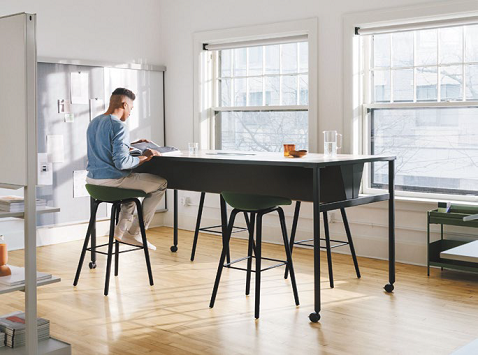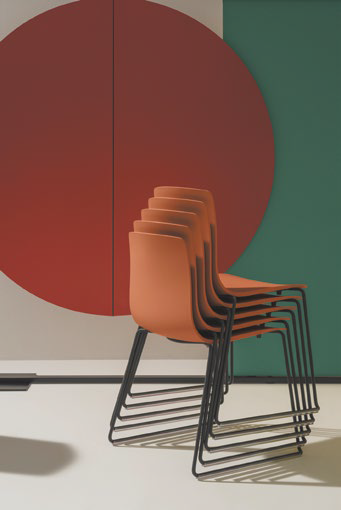Listen to the audio version of this article. Duration: 16 minutes.
The hybrid home is a new design paradigm and a flexible, intelligent response to evolving lifestyles and spatial needs.
The ongoing social transformation has given rise to domestic environments shaped by multiple, personalised needs. Homes now call for modular, multifunctional furnishings that allow a bedroom to become an office, a living room to turn into a gym, then back again. All seamlessly integrated with smart technology.
.png)
Even though the idea has been discussed and developed for at least two decades, it was only after the 2020 pandemic that interior design began engaging daily with a new anthropological and socio-cultural category: the hybrid home. This is a response to a shared, global need, a democratic shift that has become far more than a trend. It is now a genuine paradigm, playing a disruptive and central role in the social transformation happening at all latitudes.
Today’s domestic walls are more fluid, modular and open, not only outward but also internally, creating seamless transitions within the home itself. In fact, it is precisely the domestic space that reveals how shifting habits and daily needs are shaping market responses. Design gives form to this shift, translating it into spaces we can live in. Its adaptive, flexible and multifunctional nature, unconstrained by rigid conventions, makes it uniquely suited to meet the needs of today while anticipating those of tomorrow.
Hybrid spaces have been defined as mobile environments shaped by the constant motion of those who inhabit them. Ongoing social change, demographic growth, the breakdown of the traditional family structure, tighter budgets and longer life expectancy have led to spaces with multiple needs. Rooms now require modular, multifunctional furniture that can turn a bedroom into an office, or a living room into a gym and back again. All with furnishings that adapt quickly and comfortably to the varying demands of a day, with smart-working and home fitness now key structuring activities.
The new hybrid design, in its adaptive and flexible nature, shapes domestic life in the present while envisioning how we will live in the future.
Homes and furnishings that speak different languages at different times of day. Conscious furniture. Optimised spaces. Personalised environments.
Hybrid spaces have become the new normal, incorporating ergonomic and technological workstations into domestic design without compromising the aesthetics or functionality of shared areas. Folding tables, movable walls and smart storage solutions allow a living room to transform within minutes from a productive office into a relaxing retreat. The key is to design environments that support both productivity and wellbeing, through suitable lighting, acoustically protected areas and decorative elements that foster relaxation and focus. Optimisation is also crucial, with shelving and storage designed to maximise ceiling height, and intelligent lighting and climate systems that respond in real time to how the space is used.
Practicality, aesthetics and multipurpose technology are the pillars of increasingly hybrid homes, designed for people who live between work and leisure. A smart home for smart inhabitants. This new paradigm addresses practical needs, improves comfort, simplifies life and even helps save time. Interior design is now called to rewrite the language of modernity, integrating the many identities a person may embody over 24 hours, and interpreting spaces that reflect a society constantly on the move. Life outside the home now inspires and contaminates life within it, always tending to daily needs.
At the same time, we must remember that today’s consumer is also the co-designer of the home, a space of living, working, relaxing and fitness, all linked by mobility. Hybrid homes are best equipped to interpret this cultural shift. Those living a mobile lifestyle require versatile, modular and multifunctional environments. Designing hybrid domestic spaces is the most useful form of dialogue between intuition and necessity, between creativity and a marketplace increasingly shaped by the consumers themselves. Today, those who inhabit a home also inhabit the market.
Adaptive, flexible design understands this well, helping to infuse the home with inclusivity, meaning the ability to serve the people who live in it and their individual needs. These are homes and furnishings that speak different languages at different times of day. Conscious furniture. Optimised spaces. Personalised environments. Because today, it is the home that adapts to its inhabitants, not the other way around.
Home Decor 2025: The Keyword is Technology Sync
In 2025, functionality and aesthetics of interior design cannot exist without smart technology to fulfil the promise of hybrid living. The smart home is increasingly integrated into décor, not only through connected appliances, but also via interactive finishes and technological tops. Meanwhile, furniture continues to evolve, becoming ever more multifunctional, with integrated lighting, security and climate systems controlled via app, and beyond. Even smart fabrics that respond to heat or light, and humanoid elements, no longer belong solely to dystopian futures.

OE1 Workspace Collection by Herman Miller
In a landscape where flexibility defines the modern workspace, Herman Miller’s OE1 Workspace Collection reimagines office design with a fluid, modular and highly responsive approach. Created for an era of continuous change, OE1 allows individuals and organisations to experiment, reconfigure and transform their spaces according to present needs and future perspectives.
Agility stands at the heart of OE1. With multifunctional elements and mobile units, the collection easily integrates into existing environments or helps generate entirely new ones. Whether for individual workstations, collaborative zones or informal lounge areas, OE1 turns underused spaces into dynamic, high- performing hubs. A broad range of configurations and colour options makes the collection visually versatile, adapting to diverse aesthetics while maintaining functionality and coherence. Its clean, expressive design language balances minimalism with everyday performance, responding directly to the demands of contemporary work: mobility, modularity and immediacy. With OE1, Herman Miller is not just furnishing spaces, but shaping how we inhabit and interact with them.

Mobility is not just a means of getting around, but an existential condition that redefines identity, relationships and space, both inside and outside the home.
The new paradigm for a sustainable home is usability.

Aava 02 Design by Antti Kotilainen
An example of classic minimalism that looks confidently to the future, Aava 02 reinterprets a timeless silhouette through the use of sustainable, next-generation materials. The chair is crafted from post-consumer recycled plastic blended with virgin polypropylene, offering exceptional durability without compromising its refined aesthetic. The material, reinforced with glass fibre, ensures long-term strength and consistent colour quality. The full range of chairs and stools can be finished in recycled plastic, FSC-certified wood or a wide variety of fabrics. Upholstered versions are entirely glue-free, making them easy to disassemble for full recyclability or reuse. Aava 02 is a manifesto for conscious design, where essential form meets material innovation.
Interior designers are now called to rewrite the language of modernity, interpreting spaces that reflect a constantly evolving society.

Mobility is no longer merely a way to move. It is an existential state, shaped by both choice and necessity, and it redefines identity, relationships and space. This was argued more than a decade ago by sociologists Anthony Elliott and John Urry, who explored the concept of mobility as the movement of people, objects, information and capital in contemporary society. They demonstrated how mobility reshapes identity, social relations and economic structures. Today, mobility is both physical and virtual, or rather, phygital. It is fluid, evolving, even fragmented. Work is increasingly a network of mobile connections where location matters less than the ability to remain constantly connected. True connection now transcends physical space.
The concept of the “mobile office” and “digital nomadism” are by-products of this transformation, but so are “domestic mobility” and the “modular home”, or hybrid home, which at first glance may seem contradictory. Within this context, the sustainability paradigm also shifts, or rather, expands in meaning.
A sustainable home is one that does not harm the environment, strain finances, or fall short of the occupant’s needs. Usability thus becomes a foundational element of the hybrid paradigm, directly impacting long-term sustainability. A multipurpose space is, by nature, more sustainable over time because it can easily adapt to changing needs. What’s more, by bringing together more aspects of daily life, especially work and fitness, hybrid spaces reduce the need for travel and therefore lower environmental impact.
SLIDING ROOMS: How hybrid living reshapes domestic spaces in Milan
In the heart of Milan, three historic buildings have been transformed into a new model of urban housing. Spazio Trivulzio, a build-to-rent project developed by Hines, explores a flexible way of living for modern city dwellers. The interiors, furnished by LAGO, reflect a new approach to design that merges modularity with emotion and redefines how space is experienced, shared and lived in.
A new kind of domestic space is emerging in Milan, one that blends private comfort with shared living, functionality with emotion. Spazio Trivulzio offers a fresh take on the home, shaped around the changing needs of those who live on-the-move. Developed by investment group Hines, the residential complex introduces a build-to-rent model centred on community, flexibility and contemporary design. Housed in three traditional Milanese buildings, the project features 78 apartments and more than 1,000 square metres of common areas.

Residents have access to co-working spaces, a gym, lounge, bike storage and even a dedicated repair workshop. The design encourages a sense of belonging without compromising on individual privacy.
Each apartment is fully furnished with designer modular interiors developed by LAGO to support multiple ways of living. Two mood-based finishes are available. The first, Intense, is bold and expressive, designed for those who want their space to reflect a strong personality. The second, Nature, offers a soothing environment rooted in simplicity and clarity, ideal for those seeking balance and serenity. Both are conceived to help residents transition easily between home, work and leisure.
The interiors combine warm surfaces and transparent elements to create rooms that feel open yet personal. It is a setting conceived not just for function, but also for daily rituals, connection and presence.
«We are responding to a cultural shift in housing. Today’s homes are no longer static places but spaces of flow, exchange and transformation.»
Gilberto Negrini, LAGO’s CEO

Air Table - Design: Daniele Lago
A design icon that challenges traditional ideas of volume. Two sleek, nearly invisible tempered glass legs support a wide, solid tabletop, creating the striking impression of suspension in mid-air. The result is a dining table that brings lightness and transparency to the room. The legs are available in extra-clear or smoked glass, while the tabletop comes in a wide range of finishes, from the warmth of Wildwood oak to the refined look of glass and XGlass. The thermally treated Wildwood surface offers excellent resistance to wear and is impermeable to liquids, while the tempered glass legs ensure maximum durability against impacts and thermal shifts. An adjustable support system and transparent rubber feet guarantee perfect stability on any surface. Available in lengths up to three metres, Air is a table designed for social living and shared spaces.

Air Nightstand - Design: Daniele Lago
Minimalist volumes rest on tempered glass supports, bringing lightness and elegance to the bedroom. This freestanding bedside table requires no wall anchoring and can also be placed at the centre of the room. Thanks to its modular design, it adapts effortlessly to different spatial needs. Made from precision-cut aluminium with 45° joints, it combines structural integrity with clean aesthetics. Available in a wide variety of materials, including wood, glass, marble, metal and XGlass, it offers numerous compositional possibilities, each with strong visual presence.

Air Coffee Table - Design: Daniele Lago
With clean lines, refined materials and a sense of suspension, the Air Coffee Table is supported by solid legs in extra-clear tempered glass, giving the top a floating appearance. Fully customisable in size and finish, it adapts with ease to both spacious and compact settings. It is available in Wildwood oak, lacquered glass, or the full range of XGlass finishes, including marble, metal, wood and textile effects, creating a unique and sophisticated focal point in the living area.
Copyright © Homa 2025
All rights reserved

.jpg?VGhlIFBlcmZlY3QgU2xvdC1pbijmraPnoa4pLmpwZw==)

































